The Roman Soldier's Belt:
Cingulum Militare or Balteus
The belt
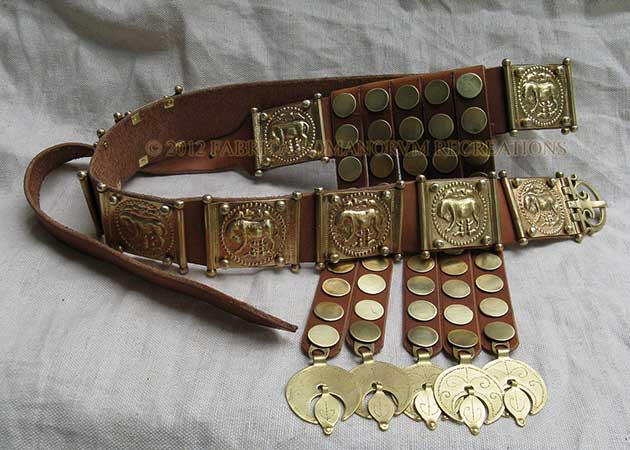
Balteus Reproduction by Matt Lukes
The terms "cingulum" and the "balteus" are often confused and/or used inter-changeably For us, we will use the term "cingulum." The cingulum is the traditional Roman soldier's military belt. The term "cingulum" can also refer to the baldric-style belt used to carry a gladius, pugio, loculus, etc. When you think of the Roman soldier, one of the things you think of, is the dangling straps (called baltea) hanging at he front of his belt.
The Mark of a Soldier
The Cingulum is the mark of the soldier — not only that, it's really a status symbol of being a soldier. Worn at all times, even off duty, only soldiers were allowed, by law, to wear this unique belt. It may have had some defensive capabilities; it may represent rank or awards… it is more likely way for the soldier to show his status... we just don't know. The archaeological evidence suggests that some of these belts were plain and sparsely adorned, many however, were intricately elaborate. One theory is that since Roman soldiers did not have a lot to spend their pay on, (wine and women), they spent it on making their gear fancier — as a status thing. Is this the way it was? Who knows, but modern soldiers sure do this kind of thing — think about it…

 <<< An original Roman military buckle attached to a "lamna" plate.
<<< An original Roman military buckle attached to a "lamna" plate.
It is thought that many soldiers had, or at least astarted with a simple belt. Reenactors tend to want to look "salty"; like a veteran and to do so right out of the gate. Real soldiers do this too, as witnessed by things like WW2 Afrikakorps soldiers bleaching their hats to look worn. The thing is, reenactors also tend to buy and wear what they see other reenactors wearing and that isn't always right. In the case of the cingulum, most of the reproduction belts that you see for sale now are mass-manufactured in the sub-continent and for some reason ( cost, I guess) those companies have this need to cast everything, thus making the belts heavy — like a diver's weight belt. Ugh.
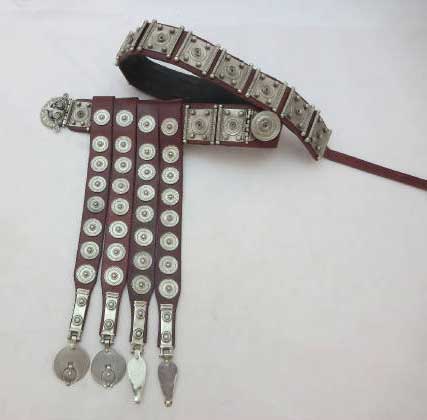 If one were to look on the Internet, it would give the idea that the Roman soldier's cingulum was crude or looked "craft-like", almost like
something found at a Tijuana flea market. However, that just wasn't the case — these men had little to spend their money on and in most
cases, spent it on things like this.
If one were to look on the Internet, it would give the idea that the Roman soldier's cingulum was crude or looked "craft-like", almost like
something found at a Tijuana flea market. However, that just wasn't the case — these men had little to spend their money on and in most
cases, spent it on things like this.
Shown here is one of the better reproduction belts made by Deepeeka. It is called their "Tekije belt with tassets" — "Tassets" being the result of some poor translation (collectors and reenactors would most likely call it an 'apron'). Deepeeka also makes and sells the belt without the baltea (apron). >>>>

Shown below is a detail shot of the buckle, "lamna" plates and the baltea of the "Tekije belt".
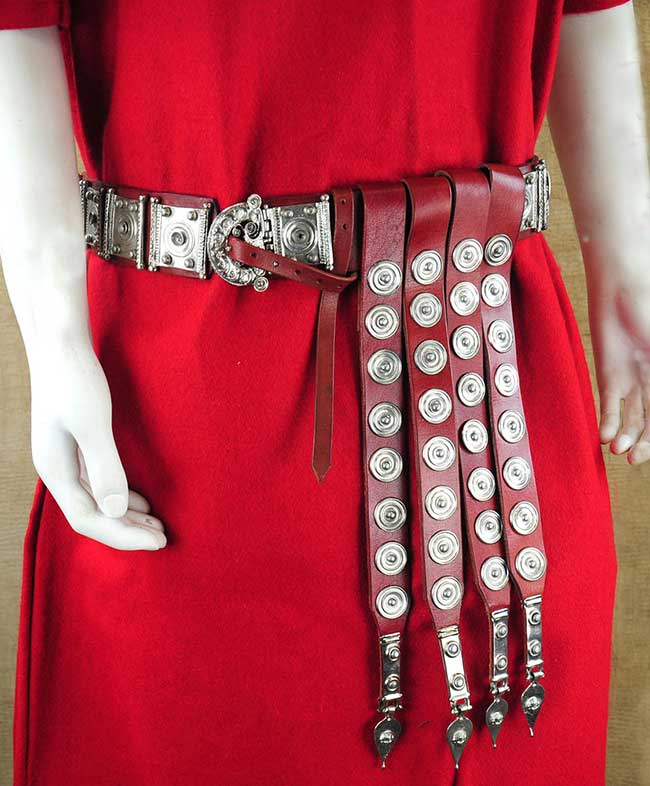
Shown below is a detail shot of the baltea penisilium of the "Tekije belt". One should point out that this is an error from Deepeeka, in that the original Tekije belt had the "lunar" penisilium tips like in the first belt photo on this page — this tip was used as an end for the belt end. C'est La Vie!
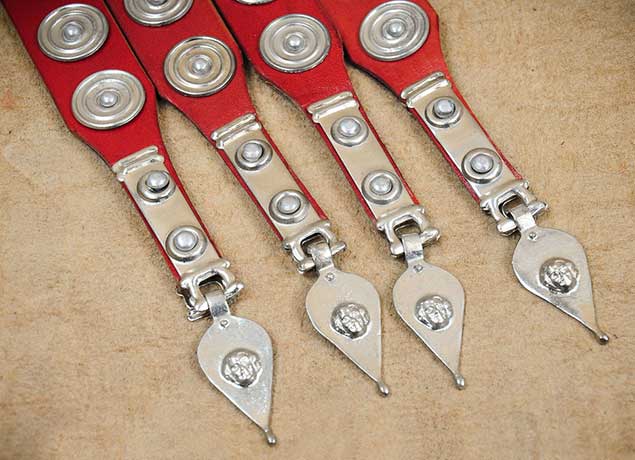
Another decent reproduction from Deepeeka is their Reingonehim Cingulum which does not come with baltea. It has a more "fine" look than most of the repros.
Shown below, is Deepeeka's "Reingonehim Cingulum".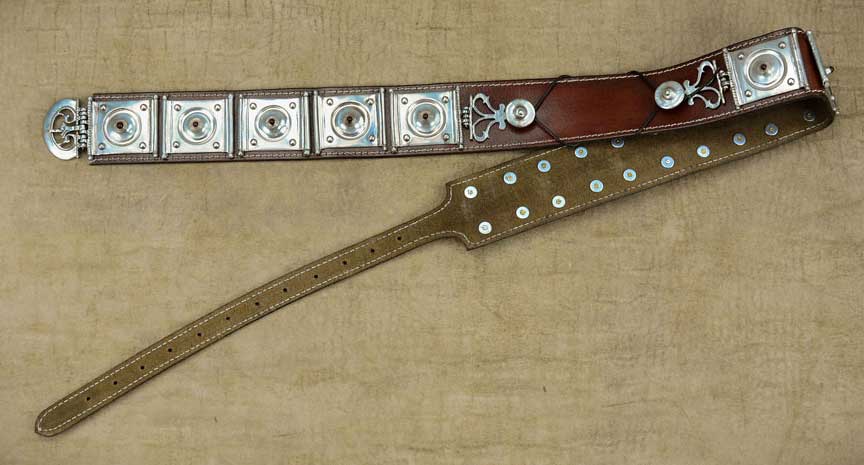
Here below, is a good detail shot showing the buckle and plates of the Deepeeka "Reingonehim Cingulum". Yes, there is a glass "jewel" in the center of the "lamna" plates.

Hammered, not cast
In fact, many of the originals were made with hammered plates, not cast. If you'd like to see some really, REALLY nice representations of what the real deal looked like, I highly suggest that you go to the website of Legio III Scythica in Bulgaria and look. You will see how the belts should be. As with all things, you get what you pay for.
"Gunslinger style" belts
Earlier, in the 1st Century AD, a different kind of belt was worn. It was thinner, with longer, cast rectangular plates. Sculptural evidence suggests the existence of double length cingulum — essentially a thinner belt (with cast belt plates) long enough to go about the soldier's waist twice, or perhaps there were two of these thinner cingulum — we don't really know. These type belts were used more in the “Augustan” period… This will be next on "our things to do" list — just like going over and showing later-Roman style belts.
Some new words — well, for modern folks

For a long time, we in the modern world and especially, Roman reenactors didn't know the correct term for the belt parts — thus using made up terms like "damglium" or "jinglium" but now, through the work of numerous collectors and reenactors, we have the actual terms.
The ACTUAL Roman military word for the hanging straps is baltea. A strap, including an apron strap, in Latin is: balteum (pl. baltea). This is the diminutive form of balteus, thus, a "little belt".
<<<< A reference drawing of baltea, bulla and a Lunar pendant (penisilium) from Drawings from Roman Military Equipment by Bishop & Coulston, Edition 2, 2006 © M.C. BishopThe studs on the baltea are called bulla like the Roman child's pendant. There was a huge amount of differing bulla produced. I have seen a large photo of an assortment, but cannot find them right now. I can tell you that Clang Armory makes a large assortment of copies of the real thing. Go on over and check his products out. Then, you can really envision how they were.
Pendant
The pendant at the very end of the "apron" strap: pensilium (pl. pensilia). Pensilium is a substantiative neuter adjective, meaning "a pendent thing." No, it doesn't mean what you think — although there have been found penisilum in the shape of that. The Romans were into that. Don't judge the past by your modern woke notions.
It is attested as piece of military gear in Granius Licianus 26.1.1, describing a type of cavalry harness pendant used by equestrian nobles.
If you are talking about the plates on the terminal of each apron strap that hold the pensilia, it is: lamna (pl. lamnae) for "plates" or balteum lamna for "strap plate" — better is balteum lamna (pl. balteum lamnis) for "strap plates."
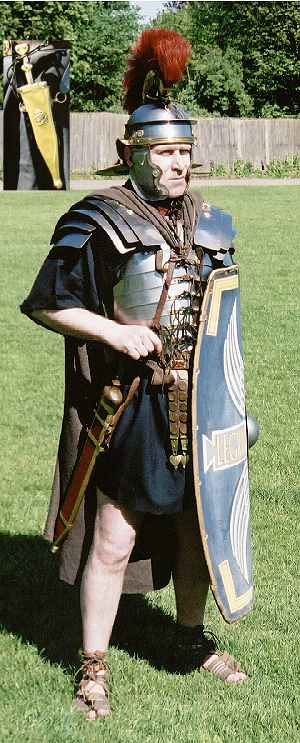 <<<< Run your mouse over and select an area on the photo to see a description of that item.
<<<< This photograph taken by the original author, Victius Maximus. Thanks to Optio Gaius Allius of Legion XIV and Verulamium Museum for their assistance
<<<< Run your mouse over and select an area on the photo to see a description of that item.
<<<< This photograph taken by the original author, Victius Maximus. Thanks to Optio Gaius Allius of Legion XIV and Verulamium Museum for their assistance




















